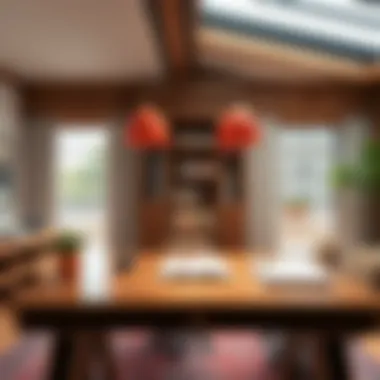Exploring Wooden Study Tables: Design and Functionality


Intro
In the world of interior design, wooden study tables have carved out an enduring niche. These pieces of furniture are not just functional; they embody elegance and sophistication, elevating any workspace to new heights. This article aims to explore the various dimensions of wooden study tables including their design, materials, and maintenance strategies, guiding readers through a maze of choices to enhance their productivity and aesthetics in study or work environments.
Every piece of furniture carries a story, and wooden study tables are no exception. With a variety of styles ranging from rustic farmhouse to sleek modern designs, they offer personalization that resonates with the unique tastes of homeowners and designers alike. By understanding the intricate relationship between design elements, material choices, and overall functionality, one can make well-informed decisions that align with contemporary trends while remaining mindful of environmental impacts.
As we navigate this comprehensive overview, we will delve into the nuances of design trends and styles, explore the types of wood that make for durable and attractive tables, and provide insights on maintenance practices to ensure longevity. Whether you're a seasoned designer, a DIY enthusiast, or a homeowner striving to create the perfect study space, this guide offers valuable knowledge that goes beyond the surface. Let’s dive in!
Understanding the Importance of a Study Table
A study table is far more than just a piece of furniture. It serves as a focal point in one’s workspace, shaping the very environment where thoughts are chiseled into reality. In the realm of education and productivity, understanding the significance of a study table can’t be overstated. This article delves into the various elements that exemplify the importance of having a well-designed study table.
Defining the Role of Study Tables
To comprehend the role of study tables, one must realize that they act as the backbone of a study environment. They provide a dedicated space designed for learning and creativity. Different people may use their tables for writing papers, conducting research, or even creative pursuits like sketching or crafting. The versatility found in the design and construction of study tables allows them to cater to varied needs.
Moreover, different users—students, professionals, or hobbyists—might require varying configurations. For instance, a student may need a larger surface area to spread out books and papers, whereas a professional might prefer a minimalist design that allows technology to take center stage.
A study table acts as a boundary, separating personal spaces from workspaces. This delineation helps to develop focus and encourages an efficient workflow. It can easily become a sanctuary where one shapes ideas, organizes thoughts and tackles tasks. Consequently, selecting the right study table is crucial to maximizing one’s potential.
Impact on Productivity and Focus
The influence of a study table on productivity and focus is significant. Imagine trying to compose an essay at a cluttered dinner table vs. a tidy, organized study space. The former can lead to distraction and hinder creative flow, while the latter promotes concentration and a sense of purpose.
Research indicates that an organized workspace leads to better productivity levels. A well-arranged study table can:
- Enhance Focus: Fewer distractions mean better concentration. The physical setup can encourage one to focus solely on the task at hand.
- Improve Posture: A proper study table often paired with a good chair facilitates better posture. This not only keeps one comfortable, it also promotes longer periods of productive work.
- Allow for Efficient Use of Time: With an organized table, touches like having necessary items within reach can help save time rather than searching for misplaced notes or tools.
An effective study table can transform a dreary living space into an inspiring arena of learning and creation.
The way an individual interacts with a study table can set the tone for their productivity. By attaching personal values such as aesthetics, comfort, and ergonomics to the choices made when selecting a study table, users can significantly alter their work habits, making them more efficient and focused.
Thus, understanding the importance of a well-constructed and thoughtfully designed study table serves as the foundation upon which improved productivity and enhanced learning experiences are built.
Material Considerations in Wooden Study Tables
When it comes to selecting a wooden study table, the material you choose is pivotal. Not only does it define the table's aesthetic appeal, but it also impacts its functionality, durability, and environmental footprint. Understanding these material considerations can empower homeowners, designers, and DIY enthusiasts alike to make informed choices that align with their needs while also complementing their spaces.
Types of Wood Used in Construction
Different types of wood bring unique characteristics and benefits to the table. Here, we break down the popular choices:
Oak
Located at the top of the list for many, oak is known for its strength and longevity. Its sturdy nature makes it ideal for a study table that can withstand daily wear and tear. One of the notable features of oak is its ability to resist scratching and denting, which adds to its appeal.
Pros:
- Highly durable, known for longevity
- Naturally resists warping and splitting
Cons:
- Can be on the pricier side, especially in premium finishes
- The weight might be cumbersome for some users
Maple
Maple is another popular wood, often appreciated for its fine grain and smooth texture. Its light color can brighten a workspace, making it feel more open and inviting. Particularly, it’s a dense hardwood, which means it stands the test of time, much like oak.
Pros:
- Highly durable and resistant to impacts
- Easy to finish and can be stained to various colors
Cons:
- Can yellow over time, which may not suit all aesthetics
- Less resistant to moisture compared to other woods
Pine


Contrarily, pine is typically light, both in weight and color, creating a relaxed vibe in a study space. This wood shines in its affordability, making it an attractive option for budget-conscious individuals. However, it's essential to note that its soft nature makes it more susceptible to damage.
Pros:
- Economical, making it accessible to many
- Light weight, easy to transport or move
Cons:
- Prone to scratches and dents, requiring more maintenance
- Not as durable as hardwood options
Walnut
Walnut tables ooze sophistication and class with their deep, rich color. Renowned for its beauty, walnut is often chosen when aesthetics are a priority along with functionality. It’s considered one of the premium woods on the market, lending a touch of luxury to any study that features it.
Pros:
- Remarkably beautiful with intricate grain patterns
- Durable and can handle heavy use
Cons:
- Higher price point may not be feasible for everyone
- Dark wood may absorb more heat, affecting comfort in direct sunlight
Sustainability and Ethical Sourcing
The sustainability of materials is a growing concern in today’s eco-conscious world. When individuals choose wooden study tables, it is essential to understand where the wood comes from and the practices involved in sourcing it. Selecting wood from well-managed forests ensures that tree harvesting won’t impact ecosystems negatively. Noticeable brands often signal to consumers their commitment to responsible practices, as certifications like Forest Stewardship Council (FSC) mark give a nod to those making environmentally sound choices.
Choosing sustainable materials not only contributes to the environment but also instills a sense of responsibility in consumers. Thus, investing in ethically sourced wood can be both a stylish and conscientious choice.
By considering material options and prioritizing sustainable practices, one can effectively harmonize functional needs with aesthetic desires while also playing a part in preserving the natural world.
Design Trends in Wooden Study Tables
In the realm of study tables, design is not just about aesthetics; it's a confluence of functionality and personal style. Understanding the trends that govern the design of wooden study tables can offer homeowners, designers, and enthusiasts insight into what shapes a productive and appealing workspace. A well-designed table not only boosts efficiency but also complements the overall ambiance of a room, making it imperative to stay abreast of current trends.
Minimalist Aesthetics
The minimalist aesthetic has taken the design world by storm, and for good reason. Stripped of unnecessary ornamentation, minimalist wooden study tables focus on clean lines and simplicity. This trend speaks to the modern person's demand for clarity and organization in their workspace. Less clutter means more focus, allowing users to concentrate better on their tasks. By choosing a minimalist study table, one can create a serene atmosphere, highly desirable in an age filled with distractions.
Moreover, minimalist designs often allow the beauty of the wood grain to shine through. Whether one selects a fine-grain oak or a smooth maple, the natural characteristics of the wood become the focal point. The subdued appearance also means these tables can fit seamlessly into various room styles, from contemporary urban apartments to cozy country homes.
"Simplicity is the ultimate sophistication."
This quote rings particularly true in the case of minimalist study tables.
Rustic Charm vs. Modern Lines
When discussing design trends, it’s essential to compare the rustic charm of traditional wooden tables with the sleek, modern lines of contemporary designs. Rustic wooden study tables often embody warmth and character. They might showcase distressed finishes, thicker profiles, and a certain ruggedness that adds history to a space. This style is perfect for those who appreciate craftsmanship and wish to infuse their workspace with a sense of nostalgia. Using reclaimed wood, for example, not only tells a story but also supports sustainability.
On the flip side, modern lines reflect a more industrial or Scandanavian influence, leaning toward functional yet sophisticated forms. These tables may feature smooth surfaces, integrated storage options, and smart designs that cater to the demands of today’s tech-driven world. The beauty of the current design landscape lies in the balance of these two contrasting styles.
Homeowners can mix and match elements—perhaps pairing a sleek, modern table with rustic decor, creating a unique blend that showcases both styles beautifully. Choosing between rustic charm and modern lines ultimately hinges on personal preference and the specific ambiance one wishes to cultivate in their study space.
Functional Features of Study Tables
When it comes to wooden study tables, the functional features play a paramount role in elevating the user experience. A well-designed study table isn't just a flat surface to place a book or a laptop on; it's a hub of productivity, a space where ideas come to life, and a manifestation of personal style. Thus, understanding what to consider helps in choosing the perfect piece of furniture that caters to both efficiency and comfort.
Size and Space Considerations
Selecting the right size for a study table is akin to buying shoes – a perfect fit makes all the difference. Measure your space and consider not only the footprint of the table but also how it fits into the overall room layout. Here are a few points to bear in mind:
- Room Dimensions: Whether it’s a cozy nook or a sprawling home office, understanding the dimensions of your space is crucial. Opting for a table that is too large can create a cramped atmosphere, making it challenging to concentrate.
- Height Matters: Standard desks are around 28 to 30 inches high, but personal comfort matters. Adjustable height tables can be particularly useful for individuals who may want to switch between sitting and standing while working.
- Proportional Fit: If you're working with smaller furniture, you don't want an oversized table dwarfing the room. Conversely, in a luxurious, large setting, a dainty desk might feel lost or instance.
- Accessibility: Ensure enough clearance for chairs and movement. It’s essential that you can pull your chair close without bumping into walls or shelves.
These considerations don’t just influence functionality, but also contribute significantly to the room’s visual balance. A well-sized table can enhance the aesthetics while ensuring the workspace remains practical.
Storage Solutions and Ergonomics
Storage isn't merely a bonus feature; it's often a necessity in our clutter-laden lives. Having organized space can greatly affect how well one studies or works. Here are several storage aspects to ponder:
- Integrated Storage: Many wooden study tables come with built-in drawers or shelves. This design keeps essential items within arm's reach while maintaining a clean desk surface. Think of it like the kitchen drawers – you may not see them, but good organization makes everything run smoother.
- Vertical Space Utilization: Gone are the days of solely horizontal storage. Vertical bookshelves or wall-mounted units can save significant space while providing ample storage. It’s an elegant solution that combines form and function seamlessly.
- Ergonomic Design: Next, let’s discuss ergonomics. This is all about how the furniture supports you during long hours of work. A table should promote good posture, reducing strain on the back and neck. Features such as a lower table height or an overall design that encourages an open workspace can achieve this effect.
- Easy Reach: It’s vital that storage solutions are easy to reach and use. If you’re constantly stretching or bending awkwardly to grab essentials, that desk will quickly become a source of frustration.
By adopting a combination of functional storage features and ergonomic principles, a wooden study table can transform into a sanctuary for learning and creativity.


"A workspace that is both functional and comfortable can boost creativity and productivity significantly."
Ultimately, these factors converge to create a study environment that isn’t just pleasing to the eye but highly efficient and conducive to concentration. As you assess options in wooden study tables, remember that functionality paves the way for a rewarding study experience.
The Intersection of Technology and Study Tables
In the contemporary world, technology influences nearly every aspect of our lives. Study tables, once merely pieces of furniture designed for writing, have evolved to accommodate the digital age. This transformation is not merely aesthetic; it's functional, aiming to blend comfort with efficiency. Today’s wooden study tables not only serve as a workspace but also act as hubs of technology.
As people shift towards remote working and online learning, tables that integrate tech-friendly features have become indispensable. In this section, we will explore the ways in which technology intertwines with study table design and functionality, enhancing productivity and user experience.
Incorporating Tech-Friendly Features
Charging Ports
One of the leading features in modern study tables is the integration of charging ports. This aspect addresses a common pain point today—the need for power sources in our increasingly digital world. With the proliferation of laptops, tablets, and smartphones, a convenient charging port built into your study table can be a game changer.
- Convenience: Having charging ports right at your fingertips eliminates the hassle of hunting for outlets, allowing you to stay focused on your work.
- Increased Productivity: You can keep devices charged while using them, reducing interruptions and keeping your workflow smooth.
- Unique Features: Some designs include fast-charging capabilities, which can be a significant time-saver.
However, there’s a catch. Overcrowding with electronic connections can make a table appear cluttered, which undermines the aesthetic appeal of a carefully curated workspace.
Cable Management
Cable management is another indispensable feature in tech-integrated study tables. As much as the digital devices have advanced, they come with a tangle of wires that can turn an organized desk into a chaotic mess. Effective cable management is about organizing these cords to create a cleaner, more professional look.
- Aesthetic Appeal: A tidy space welcomes creativity and focus. Having a system in place to secure cables can help in maintaining that calm atmosphere essential for studying or working.
- Safety Considerations: Properly managing cables minimizes the risk of tripping hazards, particularly in homes with children or pets.
- Unique Features: Many modern tables incorporate cable baskets or routing holes, which facilitate easy access while keeping cords out of sight.
Yet, a potential downside to consider is that a highly integrated cable management system may complicate access when changes or upgrades are needed.
Smart Study Tables in the Modern Age
As we venture further into the 21st century, the concept of the smart study table emerges. These digital marvels are not just pieces of furniture; they essentially become companions in education and productivity. They often come equipped with features like adjustable height settings, built-in speakers, and even IoT compatibility, connecting your devices seamlessly.
These innovations cater to the specific needs of users, making work environments more adaptive. For example, students can switch between standing and sitting with ease, which is beneficial for health and concentration. The proliferation of smart study tables reflects a trend towards creating highly personalized workspaces, serving as a bridge between traditional wooden craftsmanship and modern functionality.
"The blend of classic design with innovative technology not only enhances functionality but also elevates the way we experience our personal study environments."
Choosing the Right Wooden Study Table
Selecting the right wooden study table is a vital aspect that directly impacts both productivity and comfort in study or work environments. The increasing array of choices on the market makes this process both exciting and overwhelming. A well-chosen table can serve as a cornerstone of your workspace, providing not just utility but also enhancing the overall ambiance. Therefore, it is essential to consider several factors before making a decision, ranging from functionality to aesthetic fit.
Assessing Your Needs and Space
Before diving into options, understanding your specific needs is key. Knowing what you require from a study table will streamline the selection process. When you're assessing your space, take the following into account:
- Size of the Room: Measure the available area where the table will reside. Is it a compact nook or a spacious home office? Smaller rooms could benefit from tables with cleaner lines and multi-functional designs.
- Height Requirements: Ergonomics play a massive role in comfort. Be mindful of your height and seating arrangement. An awkwardly tall or short table can lead to discomfort over time.
- Usage Frequency: Consider whether this table will be used daily for long hours or occasionally for quick tasks. Higher use demands more durable materials and features, such as storage or cable management.
Having a clear picture of your space needs allows you to focus your search effectively. It eliminates options that otherwise may not fit or suit your intended purpose.
Evaluating Quality and Durability
After clarifying your needs, the next step involves evaluating the quality and durability of the tables on your shortlist. A high-quality study table not only serves you well but also represents a sound investment. Here are some pointers that can guide you in this process:
- Material Examination: Look closely at the specific types of wood used. Hardwoods like oak or walnut are generally more resilient but might come at a higher cost. Weaker woods, like particle board, may not endure heavy use.
- Joinery Techniques: Investigate how the table is constructed. Tables that use mortise and tenon joints or dovetail construction tend to be sturdier and long-lasting compared to those formed with basic screws and glue.
- Finish and Coating: A decent finish not only protects the surface but also enhances the wood's natural beauty. Depending on your usage, finishes like lacquer and polyurethane provide various levels of protection against scratches and spills.
"Investing in a high-quality wooden study table is like buying peace of mind, knowing it will withstand the rigors of daily life."
Recognizing these elements aids in ensuring the longevity of your wooden study table. This attention to detail elevates the overall experience of working in your space, making every session at the table not just productive but enjoyable.
Maintenance Tips for Wooden Study Tables
Wooden study tables are more than just functional furniture; they are often a significant investment. Proper maintenance is essential to ensure their longevity and aesthetic appeal. This section underscores the importance of taking care of these pieces, emphasizing that a little effort goes a long way. Not only does maintenance preserve the quality and appearance of your table, but it also enhances the overall atmosphere of your study space. When your table looks good and functions well, it can significantly contribute to your productivity and focus.
Cleaning and Upkeep
Keeping your wooden study table clean and well-maintained is a paramount task that should not be taken lightly. Dust and grime can accumulate quickly, and neglect can lead to long-term damage.
- Daily Dusting: Use a soft microfiber cloth to wipe down the surface. Doing this daily helps prevent dirt build-up.
- Gentle Cleaning: For deeper cleaning, mix a solution of mild soap with warm water. Dampen a cloth in the solution, wring it out well, and gently wipe the surface. Always follow up with a dry cloth to avoid moisture damage.
- Polishing: Implement polishing into your routine every few months. A good quality wood polish will help to keep the finish looking vibrant and protect against scratches. However, be cautious with the polish—too much can create a slippery surface.
- Avoid Harsh Chemicals: Never use abrasive cleaners. Harsh chemicals can strip the finish and leave your table looking worse for wear. Stick to natural cleaning agents when possible.


"Even the most beautiful piece of wood can lose its charm if neglected, like a garden choked by weeds."
By adopting a consistent cleaning regimen, you not only enhance the look of your study table but also increase its life expectancy.
Dealing with Wear and Tear
Despite our best efforts, wear and tear are inevitable with any piece of furniture, especially one that sees daily use. Addressing these issues in a timely manner is crucial.
- Scratches: Minor scratches can be minimized using a wood filler or a touch-up pen specific to the wood type. Lightly sand the area first, fill, and then smooth it out.
- Stains: Stains from drinks or food can be a nuisance. For water rings, a bit of mayonnaise left overnight can work wonders. For more stubborn stains, use a wood cleaner followed by a gentle abrasive, like baking soda mixed with water.
- Loose Joints: If you notice any wobbling, tighten screws and check joints for damage. A simple fix can often prevent a more significant issue later.
- Refinishing: Over time, the finish might dull. Depending on the wood quality and usage, consider refinishing the table completely every few years. This process can restore its original beauty and enhance protection against future damage.
In essence, regular inspection and quick attention to any issues will keep your wooden study table looking its best and working efficiently for years to come.
Maintaining your study table is not merely about preserving functionality, but it also speaks to the respect you have for your workspace and its impact on your productivity.
DIY Customization of Wooden Study Tables
In the realm of wooden study tables, the concept of DIY customization stands as a thrilling avenue for personal expression and functional enhancement. Making a study space uniquely yours not only reflects your personality but can also adapt the workspace to your specific needs. Customizing your study table allows you to integrate personal style and meet practical requirements in ways that pre-made furniture often cannot. The ability to modify your workspace to fit both your aesthetic preferences and working habits is a true asset.
Personalizing Your Workspace
Creating a workspace that resonates with your personal taste can significantly impact your motivation and productivity. When personalizing your study table, consider the following elements:
- Color Choices: Painting or staining the wood can instantly change the character of your desk. Choose colors that evoke calm or creativity. Soft blues may promote focus, while vivid yellows can spur energy.
- Unique Hardware: Replacing standard knobs and drawer pulls with something unique—like vintage glass or handmade ceramic—adds distinctiveness.
- Decorative Accents: Adding personal touches such as framed photos, artwork, or plants can make your workspace feel welcoming. A small potted succulent, for instance, can soften the wood’s natural lines and bring freshness to the environment.
- Functional Additions: Customizing doesn’t just have to be visual. Consider functionality, like attaching hooks for headphones or small shelves for books and stationery. These enhancements prevent clutter while maintaining aesthetic appeal.
Upcycling Old Furniture
Breathing new life into old wooden furniture not only contributes to sustainability but also allows for unique customization. Here are some considerations for upcycling:
- Refinishing: Stripping paint or old varnish and applying a fresh finish can make an older desk look brand-new. Sanding down the surface provides a canvas for fresh creativity.
- Modifications: Adjusting the height of the table or rearranging its structure can turn a traditional desk into a standing study space—great for those who prefer a bit more mobility during study sessions.
- Functional Transformation: An old table can be converted into a workspace combined with leisure space. For example, add a folding extension to accommodate both study materials and gaming gear.
By engaging in DIY customization, individuals not only craft their perfect study environment but also preserve resources in an environmentally conscious way. It offers an opportunity to connect creativity with functionality. The endeavor goes beyond mere aesthetics; it's about transforming spaces into reflective sanctuaries for learning and productivity.
"A workspace without personality is just a desk; with DIY customization, it becomes a canvas for productivity and creativity."
Ultimately, both personalizing and upcycling wooden study tables hold immense potential in transforming any study corner into a place of inspiration. By understanding and exploring these possibilities, individuals can cultivate spaces that bolster their learning experiences and harmonize with their lifestyles.
The Psychological Impact of Study Spaces
The design and setup of a study space can deeply influence an individual’s mental state and productivity. Understanding the psychological impacts of one’s environment is crucial for anyone from students hunkering down for exam season to professionals working from home. This section delves into two main elements that shape these impacts—color psychology and the creation of a calm, focused environment.
Color Psychology in Study Areas
Color plays a pivotal role in influencing mood and cognitive function. Different hues can elicit various emotional responses, which can either enhance or impede one’s ability to concentrate and work effectively.
- Calming Colors: Blue is often regarded as a tranquil color that promotes clarity and understanding. Incorporating shades of blue in a study space, whether through wall paint, furniture, or decorative touches, can help to create a serene atmosphere conducive to deep concentration.
- Energetic Colors: In contrast, vibrant colors like red or yellow may invigorate a space but can also be too stimulating for prolonged study sessions. While a splash of red could inspire creativity and intensity, overdoing it can lead to distractions.
- Neutral Backgrounds: Many designers advocate for softer, neutral tones for larger surfaces, allowing accent colors to stand out without overwhelming the senses. This balance enables focus while maintaining a warm, inviting environment.
As Professor of color psychology at Yale University, Dr. Oliver B. Fabrizio states,
"The right colors can transform not just the aesthetics of a room, but its function and emotional impact on those using it."
Being mindful of color choices when setting up a wooden study table can lead to not just an appealing design but a space that effectively supports one’s academic or professional pursuits.
Creating a Calm and Focused Environment
A well-crafted study space goes beyond mere aesthetics; it's about fostering a mindset of calm. Here’s how you can create such an environment around your wooden study table:
- Declutter Regularly: A tidy workspace can lead to clearer thoughts. Keep only necessary items on the table and utilize storage solutions effectively.
- Incorporate Nature: Introducing elements like plants can enhance air quality and bring a sense of tranquility. The presence of greenery not only beautifies the space but can also reduce stress and enhance concentration.
- Strategic Lighting: Proper lighting is key. Natural light is preferable, but if that’s not an option, warm artificial lights that mimic daylight can help. Avoid harsh fluorescent lights that lead to eye strain and fatigue.
- Personal Touches: Incorporate personal items that evoke positive feelings while avoiding clutter. This can include a favorite photo or a piece of art that inspires creativity and happiness.
- Noise Management: Consider how sound elements impact focus. Whether it's using noise-canceling headphones, white noise machines, or soft instrumental music, find what helps maintain your concentration.
- Consider drawer space or decorative boxes to hide distractions away.
By weaving together the right colors and creating a serene layout around a wooden study table, you cultivate an environment where clarity and focus thrive. Remember, the goal is not just to study longer but to study smarter.
Future Trends in Furniture Design
The landscape of furniture design isn't static; it sways and shifts like the trees from which wooden tables are crafted. As times change, so do the needs and preferences of individuals. This section highlights key future trends in furniture design, specifically focusing on wooden study tables. Here, we dive into vital elements like the adoption of smart materials and the evolution towards adaptive furniture that responds to life’s changing demands.
Smart Materials and Sustainability
In recent years, the term 'smart materials' has gained traction within the design community, serving as a barometer for innovation. Smart materials are those that can respond dynamically to their environment. For instance, imagine a wooden study table that can adjust its surface temperature based on room conditions, effectively providing a more compfortable workspace throughout the year.
Sustainability remains a cornerstone consideration in this evolution. With increasing awareness of environmental issues, designers are leaning toward using reclaimed woods or sustainably harvested sources. This not only contributes to the longevity of our forests but also adds character to each piece—it's like owning a piece of history.
Consider the following aspects when thinking about smart materials:
- Eco-Friendliness: Utilizing non-toxic finishes and materials that can be recycled or repurposed after their lifecycle.
- Adaptation: Designs that incorporate elements which can be rearranged or modified to suit various preferences or requiremenets over time.
- Innovative Textures: Materials that change texture when touched or heated, ready to engage the user in new ways.















